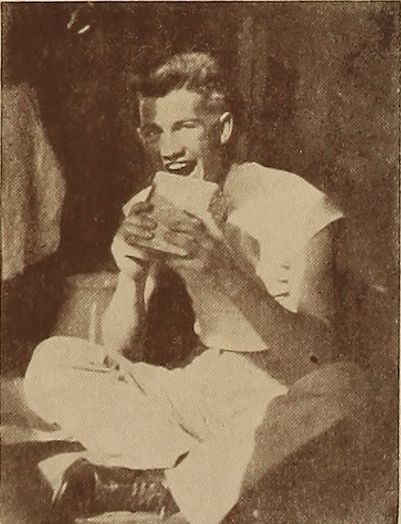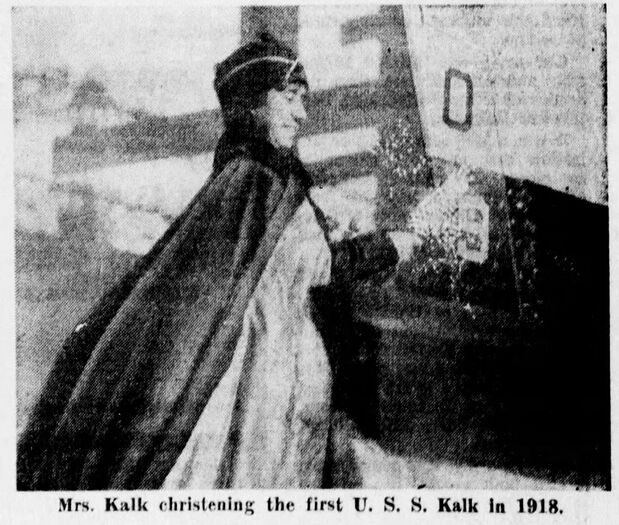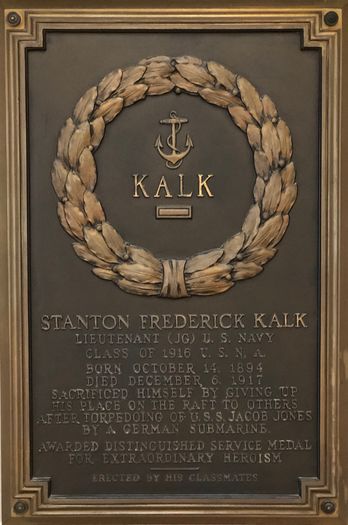STANTON F. KALK, LTJG, USN
Stanton Kalk '16
Lucky Bag
From the 1916 Lucky Bag:
Stanton Frederick Kalk
Washington, D.C.
"Sue"
HERE is a person who lives to eat. If you want to hit him where he is weak invite him out to have a plank steak, or, better yet, let him invite you, for he believes in eating at any price. And boxes.... well—the whole left wing camps outside of his door at Thanksgiving and Christmas.
Speaking of camping, sh-h-h! dangerous ground. Every year he spends part of his leave camping near the Shenandoah, and to hear him rave, "he certainly do enjoy them." When he comes back he always gets you in a corner and tells you about the—Oh! well, same old song, another verse. Before he came into the Navy he was quite a naturalist and can still tell you the "race, color and previous condition of servitude" of any bird, simply by hearing it pass by. He would rather fish off the mole at Gib than go ashore, and he will tell you about the three-foot sunfish that he almost caught there. They wouldn't bite—neither would we.
But don't gather from this that Sue hasn't attracted attention while here. Youngster Year, after winning a three-legged race, he gained renown by almost driving a winning team for the Old Seventh Company in the chariot race in regular Ben Hur style. He would have won but for the fact that the laws of physics overcame his true Roman spirit, and on rounding a turn, forced him to relinquish his command and make a flying moor at the edge of the crowd. Incidentally, he spent several days in Sick Bay.
Sue is a soccer player and shares with Captain Ziroli the honor of scoring the points for our championship team. He is supposed to have an ear for music, for he often entertains (?) Freddy with Neapolitan-like strains from his mandolin until Freddy becomes disgusted and plays (?) the thing himself.
Sue, while quiet, enjoys a rough house and is as true a friend as any man could wish. Anyone will be happy to have him for a shipmate. He is decidedly quiet, and it may require an effort on your part to become acquainted with him, but your efforts will be well expended.
"Let's go get a soda."
Buzzard; Baseball Numerals; Soccer Numerals.

Stanton Frederick Kalk
Washington, D.C.
"Sue"
HERE is a person who lives to eat. If you want to hit him where he is weak invite him out to have a plank steak, or, better yet, let him invite you, for he believes in eating at any price. And boxes.... well—the whole left wing camps outside of his door at Thanksgiving and Christmas.
Speaking of camping, sh-h-h! dangerous ground. Every year he spends part of his leave camping near the Shenandoah, and to hear him rave, "he certainly do enjoy them." When he comes back he always gets you in a corner and tells you about the—Oh! well, same old song, another verse. Before he came into the Navy he was quite a naturalist and can still tell you the "race, color and previous condition of servitude" of any bird, simply by hearing it pass by. He would rather fish off the mole at Gib than go ashore, and he will tell you about the three-foot sunfish that he almost caught there. They wouldn't bite—neither would we.
But don't gather from this that Sue hasn't attracted attention while here. Youngster Year, after winning a three-legged race, he gained renown by almost driving a winning team for the Old Seventh Company in the chariot race in regular Ben Hur style. He would have won but for the fact that the laws of physics overcame his true Roman spirit, and on rounding a turn, forced him to relinquish his command and make a flying moor at the edge of the crowd. Incidentally, he spent several days in Sick Bay.
Sue is a soccer player and shares with Captain Ziroli the honor of scoring the points for our championship team. He is supposed to have an ear for music, for he often entertains (?) Freddy with Neapolitan-like strains from his mandolin until Freddy becomes disgusted and plays (?) the thing himself.
Sue, while quiet, enjoys a rough house and is as true a friend as any man could wish. Anyone will be happy to have him for a shipmate. He is decidedly quiet, and it may require an effort on your part to become acquainted with him, but your efforts will be well expended.
"Let's go get a soda."
Buzzard; Baseball Numerals; Soccer Numerals.
Loss
Stanton was lost when USS Jacob Jones (Destroyer No. 61) was torpedoed and sunk by a German submarine between Brest, France, and Ireland. He was the officer of the deck, and "though stunned by the explosion and weakened by his action after the ship went down, Kalk swam from one raft to another in an attempt to equalize weight on them. Displaying "extraordinary heroism," he disregarded his own condition while endeavoring to save the lives of his men. Game to the last, Kalk overtaxed his own strength; he died from exposure and exhaustion."
Other Information
From researcher Kathy Franz:
Stanton was born in the Mount Vernon Barracks, Alabama. When he was three years old, his father Frank died in a railroad accident in Burlington, Iowa, on March 5, 1898. He was stationed as commandant at the Iowa Wesleyan University at Mt. Pleasant.
Stanton, his mother, and his sister Josephine went to live with her parents. His grandfather was Army General Thaddeus Harlan Stanton. During the Civil War, he was known as the “fighting paymaster.” He served during the Indian Wars including the Little Big Horn Campaign in 1876.
In 1907, at the age 12, Stanton was appointed a page in the United States Senate upon the recommendation of Senator Millard.
Stanton attended the Thomas P. Morgan School and then Western High School in Washington, D. C.
In June, 1910, Stanton was appointed to the Naval Academy by Senator Norris Brown. He entered the academy in 1911; however, in February, 1912, Stanton was forced to resign with 14 others because they failed the semi-annual examinations. All were reinstated, and Stanton and five others graduated with the Class of 1916. The rest were non-graduates.
After graduation, Stanton went on duty on the superdreadnaught Florida.
Stanton applied for a passport in August, 1917, to go to England. He was 5 feet 6 ½ inches tall with gray-green eyes and light hair. He was not on the original list of those on the USS Jacob Jones; but once he reached England, he was assigned to her.
Omaha Daily Bee, January 27, 1918
… According to [Admiral Worth] Bagley’s report, this young Stanton Kalk, only 23, showed courage, resourcefulness and self-sacrifice in the highest degree when the test came. Personally he was gentle and lovable and appreciative of things far removed from the cruelties of war. Touching evidence of these qualities in his devotion to his mother have come since he has “gone.” Papers insuring his life for her, a beautiful Irish lace shawl for her Christmas present and several letters.
Writes to His Mother.
Our American youths’ versatility and appreciation of things outside their chosen fields of work is shown in one of the letters when he tells of having seen a bird of beautiful coloring, new to him, in England. He was an enthusiastic naturalist. He made a thumb sketch of the bird and described it to his mother and asked playfully if she thought the stuffed one of the species that he had bought and would bring home would be too large for the living room. He made a water color sketch of the Jacob Jones (he stood second in his class at Annapolis in mechanical drawing), with the sun at its back to give his mother an idea of the beautiful light effects of the sea, sun and ship combined.
Stanton’s mother christened a ship named in his honor in December, 1918. It was one of 50 destroyers turned over to Great Britain in a pre-war deal. She again christened another ship named for him in July, 1942.
When Stanton died, his mother Flora was doing Y. M. C. A. navy work in France. As a memorial to Stanton, Flora served two years (1921-1923) as the head of the Armenian Seaside orphanage at Sidon. The orphanage under the administration of the Near East Relief association housed 600 children. Previously, Flora had supervised the migration of 250 children from Turkey to Syria.
His name is listed at the Brookwood American Military Cemetery in England and on a memorial marker in Arlington National Cemetery.
Jacob Jones was discovered by divers in mid 2022.
Photographs
Painting by F. Luis Mora, depicting Lt(JG) Kalk assisting survivors of USS Jacob Jones (Destroyer # 61) after she was sunk by the German submarine U-53 off the Scilly Isles on 6 December 1917. A plaque accompanying this painting read: The Jacob Jones was sunk by an enemy torpedo between Brest and Queenstown. Lieutenant (jg) S.F. Kalk rendered conspicuous and gallant services after the ship sank by helping men from one raft to another so as to equalize the weight on the rafts. He died of exposure and exhaustion in order to save others. Lieutenant (jg) Kalk was awarded the Distinguished Service Medal posthumously. U.S. Naval History and Heritage Command Photograph.
From Hall of Valor:
The President of the United States of America takes pride in presenting the Navy Distinguished Service Medal (Posthumously) to Lieutenant Stanton Frederick Kalk, United States Navy, for extraordinary heroism in the line of his profession on the occasion of the destruction of the U.S.S. JACOB JONES by a submarine, on 6 December 1917. Lieutenant Kalk, as Officer of the Deck, when the submarine was sighted, took prompt and correct measures in maneuvering to avoid the torpedo, and later showed extraordinary heroism in sacrificing himself by giving up his place on a life raft to make room for others, as a result of which splendid self-sacrifice, he lost his life.
General Orders: Authority: Navy Book of Distinguished Service (Stringer)
Service: Navy
Division: U.S.S. Jacob Jones
Rank: Lieutenant
Namesake
USS Kalk (DD 170) and USS Kalk (DD 611) were named for Stanton; the ships were both sponsored by his mother.
Memorial
There is a plaque in Stanton's honor in Memorial Hall.
Related Articles
Norman Scott '11 was the executive officer of Jacob Jones when she was torpedoed.
The "Register of Commissioned and Warrant Officers of the United States Navy and Marine Corps" was published annually from 1815 through at least the 1970s; it provided rank, command or station, and occasionally billet until the beginning of World War II when command/station was no longer included. Scanned copies were reviewed and data entered from the mid-1840s through 1922, when more-frequent Navy Directories were available.
The Navy Directory was a publication that provided information on the command, billet, and rank of every active and retired naval officer. Single editions have been found online from January 1915 and March 1918, and then from three to six editions per year from 1923 through 1940; the final edition is from April 1941.
The entries in both series of documents are sometimes cryptic and confusing. They are often inconsistent, even within an edition, with the name of commands; this is especially true for aviation squadrons in the 1920s and early 1930s.
Alumni listed at the same command may or may not have had significant interactions; they could have shared a stateroom or workspace, stood many hours of watch together… or, especially at the larger commands, they might not have known each other at all. The information provides the opportunity to draw connections that are otherwise invisible, though, and gives a fuller view of the professional experiences of these alumni in Memorial Hall.
January 1917

The "category" links below lead to lists of related Honorees; use them to explore further the service and sacrifice of alumni in Memorial Hall.






